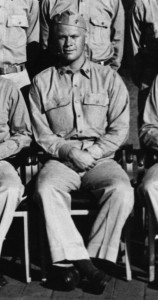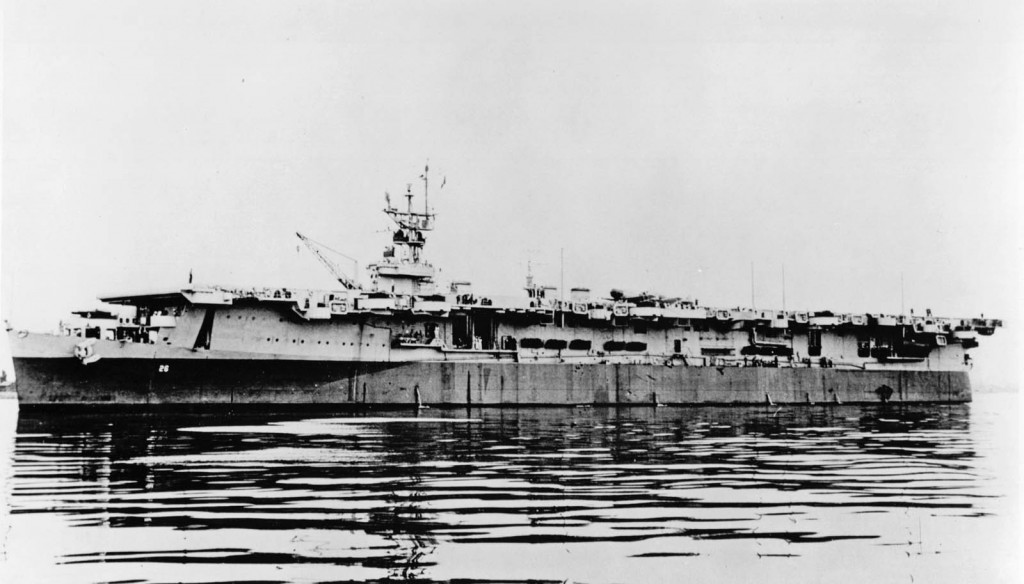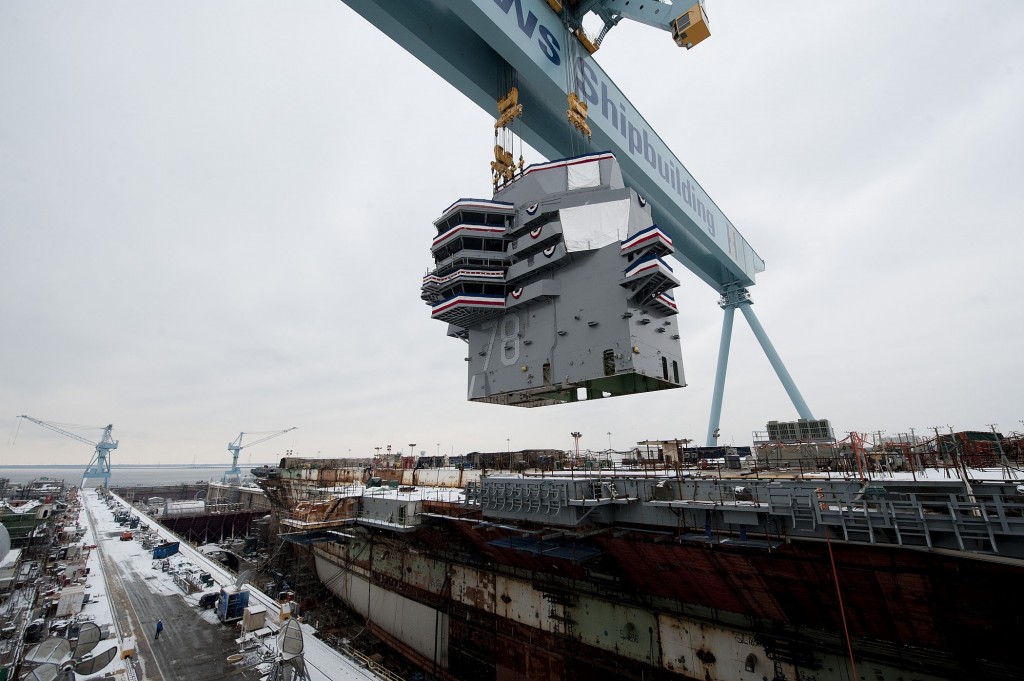In late January, shipyard workers carefully lifted the 555-ton island on to the flight deck of the Navy’s newest aircraft carrier at Newport News Shipbuilding Company in Virginia, a significant step in the journey towards the ship’s christening later this year (see photo below). CVN 78, the lead ship of a new class of nuclear-powered aircraft carriers, will be named Gerald R. Ford for the 38th President of the United States. Though he is well known for taking the nation’s leadership role in 1974 in the wake of the Watergate scandal, not many Americans realize that before serving in Congress and as President, Ford was an officer in U.S. Navy during World War II.
Ford’s early life was noteworthy for his athletic endeavors at the University of Michigan, where he was a center for the school’s back-to-back national champion football teams in 1932 and 1933. He was named the team’s MVP in 1934, and eventually had his number 48 retired by the university. He graduated from Yale Law School in 1941, and with the outbreak of World War II, was commissioned an ensign in the Naval Reserve in 1942. He initially served as an instructor and sports coach at the Navy Preflight School in Chapel Hill, North Carolina.
Given Ford’s reputation as a nationally known football star, it would have been easy for him to safely remain stateside during the war. Instead, he volunteered for sea duty, preferring to go in harm’s way. He was assigned to the light aircraft carrier USS Monterey (CVL 26), and was part of the new carrier’s commissioning crew that brought that ship to life in June 1943. The ship arrived in the Pacific theater in late 1943 and supported amphibious landings and strikes against Japanese targets through the remainder of 1943 into 1944. Lieutenant Ford served initially as the ship’s athletic director, as well as a gunnery division officer, supervising a 40mm anti-aircraft gun on the carrier’s fantail. He later moved up to assistant navigator. The ship’s greatest test came at the hands of Mother Nature; on 17-18 December 1944, Monterey was one of many U.S. Navy ships to encounter the massive Typhoon Cobra, a storm that sank three destroyers, damaged countless other ships, and killed hundreds of sailors.
On the morning of 18 December 1944, as her rolling exceeded 30 degrees in typhoon-generated winds and seas, Monterey suffered a hangar deck fire as aircraft broke loose, crashed into each other and the ship’s structure, and ignited aviation fuel. Lieutenant Ford headed for his battle station on the bridge where he assumed duties as the General Quarters Officer of the Deck – a position of significant responsibility and authority on a combatant ship in wartime. The situation was dire; directed by Captain Stuart Ingersoll to go below to assess the conflagration, Ford made the dangerous excursion down to the hangar deck and then reported back to the captain. Though the fire killed three sailors and injured nearly forty, and the ship went dead in the water for more than an hour because of smoke being sucked into the engineering spaces through the ventilation system, the crew extinguished the fire and got the ship underway – damaged but operational.
One account of Ford’s role during the typhoon mentions that the young officer led the firefighting operations. A New York Times article entitled “How Lieutenant Ford Saved His Ship” was published after Ford’s December 2006 death, and stated that “with a nod from his skipper, Lieutenant Ford donned a gas mask and led a fire brigade below” – an awkward and misleading description of shipboard damage control efforts. The article was authored by Robert Drury and Tom Clavin, who repeated the story in their 2007 book Halsey’s Typhoon. Unfortunately, there does not seem to be any supporting evidence that the future president was directly involved in fighting the hangar deck fire. A review of Monterey’s 1944 deck log and 1945 cruise book, and associated archival materials in the Navy Department Library and Ships’ History files of the Naval History and Heritage Command in Washington, DC, failed to reveal any documentary support for that claim. A similar records search by the staff of the Ford Presidential Library in Ann Arbor, Michigan came up blank. Ford’s own recollections are persuasive; his 1979 autobiography, A Time to Heal, makes no reference to leading a fire-fighting party in his brief account of the typhoon. And in a transcript of Drury’s phone interview with President Ford in 2004, obtained from author Drury with permission to transcribe the account, Ford responded to a direct question about leading the firefighting operations by stating “no. I was down there as an observer from the bridge and then I went back up to the bridge where I had my General Quarters responsibility.”
According to Captain Jerry Hendrix, USN, the current Director of the Naval History and Heritage Command, “Lieutenant Ford’s duties that day were centered on helping his captain evaluate the danger facing their ship so that the right decisions could be made to save Monterey. And working together in conditions that are difficult to imagine, Lieutenant Ford and his shipmates met the challenge. There is no reason to inflate the value of his service beyond what it really was. He was a superb example of our nation’s “greatest generation,” who served honorably, diligently and with quiet competence.”
While Ford cannot be credited with leading the efforts to save Monterey, his role as part of a combat-proven team demonstrated his courage and steady performance in crisis, a preview of things to come in a long career of public service. As we look forward to the ship joining the fleet in several years, it is important that we remember and salute the bravery and teamwork of a great American in whose honor USS Gerald R. Ford will be named.





Kenneth Fritz
admin
Dan Moore
Emily
G P
Lorraine Nichols
John Whisler
Todd Creekman
mark verrillo
Pingback: “Super” Typhoon Cobra 1944…..790 Men Lost at Sea (Killed) USN…3 Destroyers Sunk..32 Damaged | Gottalovethenavy.wordpress.com
Thomas j Beaulieu jr
Craig w saylor
Ken Iversen
Stephen King
Randy Snow
Marc A. LeBlanc
Danny McGraw
Joe mcgraw
Marc A. LeBlanc
James Cocke
ann l. Fredericks Nevitt
David phinizy
William B Phinizy
Vickie Bennett
william g. shackelford
Admin
laurie Nota
Lora V. Romero
Greg Gray